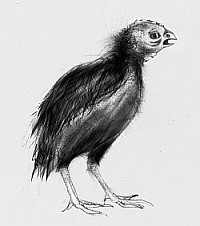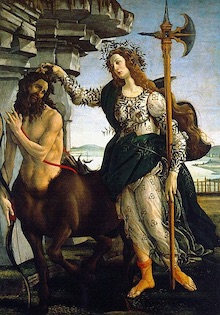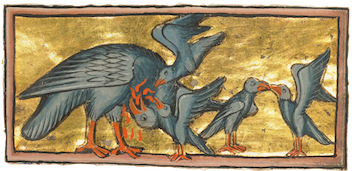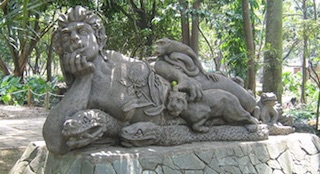Bestiary |
Yan-gant-y-tan

Breton will-o-the-wisp, native to the department of Finistère. It is said to be distinguished from other large hairy woodland men by the five candles in its right hand. A quick twist of the palm and one sees a wheel of fire. It is bad luck to see him unless you bribe that bogeyman: just leave a small bag of gold coins unattended and Fire John will grab it and disappear.
According to some sources, he is the male counterpart of the Bête havette, a water demoness who specializes in drowning children in Brittany and the Channel Islands. It usually hides in wells and pools.
Illustration: Louis Le Breton, Public domain, via Wikimedia Commons
1.9.2024 (27.4.2014)
Had se zlatou korunkou (The Snake with the Golden Crown)
is not only a Czech bogeyman, but I don't have much information about his foreign relatives, so I turn chauvinistically to my native land. So then: the snake with the golden crown (in Frýdek-Místek's legend called Zlatohlavec) is of course the head of all snakes. He's pretty touchy about his jewel, just as his crown is the target of many thieves. History records a number of more or less successful attempts to steal it.
For example, at Strašín in the Klatovy region, the usual hero of folk tales, the farm worker, attempted a robbery using the well-known serpentodemonological practice of conveniently placing a white scarf near the place where the snake king goes to bathe. The serpent did indeed defer, the farm boy waited for an opportune moment, grabbed the crown in the scarf, and made his escape. But the snake began to chase him. And since in a reptilian way, despite all his efforts and man's belief in the snake's speed, he could not catch him (the fastest real snakes can develop a speed of about three meters per second for a short while, while man can do ten), he, being supernatural, chased the thief by air. But even the art of levitation did not save the crown, and it ended up first as an ornament of Our Lady of Strašín in the local church, and later as the loot of another thief.
At other times the snake crown hunt was not successful, especially when the king was surrounded by bodyguards. Admit it, running from dozens of snakes can make you a little bit nervous. Some crowns offer themselves in an easier way, for example in Vlašim. At dawn on St. Peter and Paul's Day, one of these is up for grabs by the biggest oak tree in the local castle park. If you follow a simple rule, namely to approach the incriminated place without looking back, then you can take that jewel. However, the King's Guard is close by so you must dash across the nine boundaries to escape the snakes.
In addition to reigning in the serpent kingdom, the snakes with the golden crown were also the contractual guardians of treasures, for example under Třemšín. But not every crowned reptile is a snake king. In the castle of Pajrek near Nýrsko, the daughter of the castle lord is enchanted in the form of a golden-crowned viper. In this case, you will not lose your treasure, but it is not guarded by her but by the familiar black dog.
And finally, I have information about the snake army that is waiting at Žinkovy near Nepomuk in Černá skála (Black Rock) for the right time when the country was in the worst trouble. Then the snakes come to us to help.
So far, those suckers have never come out.
1.9.2024 (15.3.2004)
Renenutet
Ancient Egyptian goddess, of course, as was the custom of the time, a lady with an animal head. In this case, a cobra. She used to be a fertility goddess and a guide to the pharaohs, plus she took a role in wrapping the deceased in the neat form of a mummy.
She was as good at defeating enemies with her legendary gaze as she was at ensuring record harvests. Harvest time was also a common time for her official worship. The most important center of her cult was Terenuthis in the Nile Delta.
1.9.2024 (21. 3. 2004)
Ea, otherwise known as Oannes

The ruler of the deep sea, Sumer called Enki by the Sumerians, Ea by the Semites, and Oannes by the Greeks, was one of the trinity of the chief Babylonian gods. He created mankind from the clay and blood of the monster Kingu, whom the gods had to defeat along with Tiamat. He played a major role in that battle, and if it hadn't been for him, Tiamat and her horrific descendants would have been left to rule the world.
Like the later Prometheus, Ea protected his creation. An example is the subtle warning received by Utanapishtim's hut (he could not tell its owner, so he simply talked to the wall).
Wall, wall! Hearken, O Reed-hut, consider, O Wall! O thou Mortal,
Thou of Shurippak, thou scion of Ubara-Tutu, a dwelling
Pull down, (and) fashion a vessel (therewith); abandon possessions,
Life do thou seek, (and) thy hoard disregard, and save life; every creature
Make to embark in the vessel.1)
The following are construction details, which I omit because technology has advanced considerably since then. Both in the construction of the ships and in the destruction of mankind.
Ea simply loved humans, which he proved by teaching them crafts, science, and probably, according to some sources, helping to discover writing. Of course, he also practiced the secret sciences, magic, divination and medicine. According to later versions, brought back from Mesopotamia by the Greeks, Ea - Oannes in Hellenistic terms, of course - taught mankind by day and returned to the depths of the Persian Gulf by night, for like a proper sea god he had his palace somewhere at the bottom of the deep ocean.
1)
Reginald Campbell Thompson. The Epic of Gilgamesh, Complete Academic Translation
Ea in accompanying picture:
c. 2300 BC (design); 2012 (this file) [Public domain], via Wikimedia Commons
9.9.2024(28.3. 2004)
Yofune Nushi
A sea dragon that lived in a cave on the coast of the Japanese island of Oki. Among his habits was one well known to European dragons – every year, on the night of the thirteenth of June, he demanded a sacrifice in the form of a beautiful maiden. If he didn't get one, he became enraged and used storms to destroy fishing boats. Until one year, a volunteer named Tokoyo appeared on the coast. I don't know if she knew the exotic European tale of Ulysses, but she did to the serpent what the cunning king did to the Cyclops. When Yofune Nushi tried to eat her, she pulled out a knife and stuck it in his eye. The blinded dragon began to have other things to worry about than the annual dinner, writhing in pain, and it was no longer difficult for Tokoyo to do what many strong and trained men around the world could do, and what was left to weak girls, shepherds, and children to do – kill him.
14.9.2024 (28.3. 2004)
Su
A large but harmless sea monster, famous for its long tail. It is often longer than its body and is used for swimming, of course, because Su does not particularly like human company and so when it sees a boat, it disappears at record speed. Or, as you can see in some old pictures, the tail serves as an umbrella or parasol for the young su, which the old one carries on her back.
14.9.2024 (28.3. 2004)
Pěnita, or new findings about the White Lady
Today's collection of supernatural creatures comes from required school reading. Specific for my country, of course. Alois Jirasek's Ancient Bohemian Legends.
There is a whole chapter devoted to the Bílá paní (White Lady), with the main part dedicated to the most famous one, the one from Jindřichův Hradec. But apart from that, the author also mentions a number of others. There are also tales in which the lady in white is not a family ghost, but a water creature that announces death. She was called Pěnita, Parychta, Peruta, or Perchta, and in Moravia Šperechta. Which are just variants of the German Berchta by sight and hearing.
This was the South German pagan goddess (in the North, Hulda was her equivalent), who later became both an iron-nosed hag who frightened or protected children. The question of the origin of the White Lady also leads to a similar goddess. Whether she haunted the riverbank or the battlements.
14.9.2024 (4.4.2004)
Zmek or Plivník

Later, it became better known under the name Zmok, which caused demonologists in Czech countries some minor problems. There is another Zmok in the same area, a dragon that has not been seen for seven years. Isolation leaves consequences because that dragon is very dangerous.
But back to the Zmok – the Zmek.
The original Zmek was a fiery creature, probably a black snake, hence its name, and only later metamorphosed into a black chicken, a Plivník, a mischievous devil. For seven years he carried good fortune, whether as a black chicken or a red fiery one. He was occasionally harmful, but the biggest problem was to get rid of him. Why? After seven years of service, it was all about the soul. The surest way was to take it backward to the place where one came to it, one was not allowed to speak or look back during this operation.
But how a man got rid of a Plivník he had raised himself by carrying a black hen's egg in his armpit for nine days, I don't know.
Illustration by Petra Bobalová, (Full size in Gallery).
14.9.2024 (4.4.2004)
Kováříček
For the Kováříček (a little blacksmith), a half-ell high midget, I refer you to the permoniks and their rock relatives. That's where he belongs.
14.9.2024 (4.4.2004)
Jedubába
Jedubába (the Poison Hag) used to be the local form of Ježibaba. At her place, you might learn more than in the short half-sentence from Ancient Bohemian Legends, where Mr. Jirasek mentions only that the famous living and dead water is in the possession of that woman.
14.9.2024 (4.4.2004)
Centaurs

The most famous mythical nation, half human and half horse lived in Thessaly and western Arcadia. Not well spoken of in myths, the Centaurs were wild, vicious, and dangerous (with exceptions, of course). But it's a history written by the victor, for most horse people died in the Lapith Wars.
That's how the war occurred: King Peirithoos invited the Centaurs to his wedding. And because it was a proper feast at which no expense was spared, the sea of wine so overwhelmed the centaurs that they committed a series of riots under its influence, beginning with violence against the bride. A suitable casus belli was in the world, especially as the Lapiths had Theseus on their side which made them brave.
The war was fought with alternating success on both sides, and in the end, though the Lapiths had to leave their country, the centaurs lost, and ended as a nation, becoming a singular curiosity, running around Greek myth.
Apparently, belief in the centaurs, like many myths, arose from a misinterpretation of ancient images. In this case, they were probably mysteries where dancers dressed as horses summoned rain. The real Centaurs, then, were a clan with a horse totem who lived in the neighborhood of the Hellenes. The Lapiths also belonged to this cult, and according to myth, they had a common ancestor with the Centaurs, Ixion, who fathered the first Centaur with the false Hera, Nephele, believing that he was seduced the true queen of the gods. But the Lapiths, unlike the Centaurs, survived into classical times, and since they apparently looked normally human, only their cousins were left with the equine half of their bodies. Some myths, in fact, link them to the other demi-human races, the Silenes and Satyrs.
The most famous member of this nation was the Cheirón (Chiron). Unlike his comrades, he had a reputation as a gentle scholar and sage. He was the teacher of many Greek heroes and personages, such as Asclepius, Iason, Achilles, Castor and Polydeuces, or Telamon, and was at least friendly with other intrepid celebrities. Unfortunately, his friendship with the most famous of the heroes, Hercules, proved fatal.
Cheirón (originally the Thessalian god of medicine), incidentally became embroiled in a conflict between the centaurs on the one side and Heracles and the centaur Folos on the other.
Folos, otherwise the son of Silenus and the nymph Melia, once drank a glass of good wine with his friend Hercules. But Folos loaded the bellows, the contents of which were unanimously claimed by all the centaurs living in the region. A fight broke out, in which the first victorious centaurs were turned to flight by burning logs. They then fled up the coast and took refuge in Cheirón's cave in the Malian Gulf. Hercules sent several arrows after them but accidentally hit Cheirón as well. Since the arrowheads were dipped in the blood of the Lernean hydra and were therefore deadly poisonous, things got bad. In addition, Folos also scratched himself on one of them, which meant certain death for him. Not for Cheiron, who had once gained immortality. Unfortunately, that didn't extend to painlessness; the centaur was so tormented by Hydra's venom that he asked the underworld ruler Hades for a favor, and Hades took him to the underworld without even asking, exchanging his soul for Prometheus'.
Hydra's poison on Hercules' arrows also cost the life of a third well-known centaur. This was the ferryman, or actually, carrier as he ferried passengers across the Aetolian river Euena on his own back, Nessos.
He, however, unlike Cheiron and Folos, remembered for their wisdom, entered myth as a cunning kidnapper. He attempted to kidnap Hercules' newlywed wife, Déianeira. The husband, however, did not hesitate, grabbed his bow, immediately fired, and the unsuccessful kidnapper Nessos died in his victim's arms. Before Nessos breathed his last, he acknowledged that Hercules was indeed a thoughtful and honorable husband, but mockingly advised the kidnapped woman to save some of his blood just in case. If, perhaps, Hercules' feelings faded away after a while, let Déianeira smear the blood on his cloak; it would certainly save the marriage. The gullible wife obeyed and, years later, tried Nessos's instructions. The reasons that led her to do so were objective, but the result was rather cruel for the philanderer. Nessos' blood, intoxicated with hydra poison, poisoned Hercules. He ended up like Cheirón, voluntarily leaving this world to become an Immortal and live on Olympus.
Though Nessos was not of exemplary character, he still went far. He was taken up by the Romans, for them he became the patron of ferrymen and then of sailors. In that capacity, he still appears in the Mediterranean today. Along with a half-brother of the Muses, Croteus, who shines in the sky as the constellation Sagittarius, and the Centaur, representing the Centaurs in general (or just Cheiron), these are the last centaurs to be seen today.
The Centaur in the company of the goddess Pallas Athena was painted around 1482 by Sandro Botticelli [Public domain], via Wikimedia Commons
(11.4.2004)
Apitau
The belief in tree-dwelling spirits is widespread throughout the world. Although the Greek dryads are best known in Europe, their relatives can also be found in Borneo. There, the Dayaks must propitiate the tree's spirit inhabitant before cutting it down; they redeem themselves with a paste of rice, poultry blood, and eggs, which they smear on the trunk. Then, by lighting a fire, they keep the forest spirit of Apitau away. The flames must not be extinguished until the work is finished, otherwise, Apitau will return and the woodcutters will fall ill.
(18.4.2004)
Etengena
The Kiwai in New Guinea do not like to cut down solitary or prominent trees. These could be the home of a forest spirit called etengena. That's why - when there's nothing left - they ask the etengena to move out. If they are heavy-handed after a few days when they return to the tree, then the etengena has indeed moved, but only for a while, and into the Kiwais to explain that he likes this place and there is no way they will agree to repatriate him.
(18.4.2004)
Strange zoology
Many inhabitants of medieval bestiaries owe their existence to lousy observers, the big eyes of casual viewers, or the stubbornness of traditionalists. Today's bestiary will not be supernatural, for the eponymous medieval writings also spoke not only of supernatural and unnatural creatures but also of common fauna. One that, with exceptions, driven by superstition or poor observation, lived a little far from the reader.
But let's start at home, in Europe, with a fearsome creature you may meet yourself. The viper.
There are many superstitions surrounding this snake even today. However, as the Renaissance jack-of-all-trades Leonardo da Vinci himself revealed in his Bestiary, the viper is really a viper in the figurative sense in which we use it to refer to man. When mating, the female opens her mouth, opens and opens, and when the male is finished, she bites him. Nature will not let it happen, however; the little offspring that grow up in their mother's body eventually rip open her abdomen to let them out, and the murderess herself dies.
For the record, the real viper, Vipera berus, does indeed give birth to live young, or lay eggs from which the young vipers immediately hatch. But let's move on.

I've wandered a bit away from the medieval writings, I'm sorry, and I'm going right back there. Let's say to the pelican. Forget the zoo and the big white bird with a pouch under its big beak immediately. The medieval pelican is smaller, its beak short and sharp, its feathers yellow or green or whatever color the illuminator can get his hands on. Look at the picture.
You can see the peculiar behavior of this bird. First of all, I will let an authority speak for himself, namely Leonardo da Vinci as mentioned above, who selected animals for certain characteristic features in his Bestiary.
This bird has a great love for its young; and when it finds them in its nest dead from a serpent's bite, it pierces itself to the heart, and with its blood it bathes them till they return to life. 2)
From old books, he has not chosen the abundant instances in which the loving female pelican so pampers her newborn offspring as to take their lives, even while the father has the power to revive them.
An interesting beast found in the Bestiaries is the Panther. In Czech, this word has been adopted as the name for the melanistic form of the leopard, but the medieval panther was, of course, something quite different. A solitary animal with a spot on its back that Pliny says changes size according to the moon phases. Aristotle and many others after him, right up to the Middle Ages, recall the peculiar scent that the panther gives off, which attracts all animals and humans. I'm not forgetting the melodious voice. It doesn't belong here, but I can't help but think of some young ladies, fragrant and melodious, who eventually become ... no, that really has nothing to do here.
The panther didn't become a bloodthirsty monster, though. His greatest and only enemy is the dragon. The Exeter Book reveals this, and if we substitute the dragon for its usual medieval alter ego, the devil, it becomes clear why the beast was privileged to be the good guy among the Anglo-Saxons.
And that's all for today. Next time, I'll be sure to return to creatures decidedly supernatural.
2 DA VINCI, Leonardo. The Notebooks of Leonardo Da Vinci — Complete, Translated by Jean Paul Richter
The sacrificial pelican in the picture: Getty Center [Public domain], via Wikimedia Commons
(24.4.2004)
Madremonte

In Colombia, the Mother of the Mountains is considered the protector of nature, not only that geologically wrinkled one. A tall lady with bony hands, big teeth, and shining eyes, with a tangle of plants and moss for hair, dressed in leaves, she lives – depending on the region – now in the jungle, now in the swamps. The mountains, of course, are no exception; in the country through which the mighty Cordilleran ridge runs, it could not be otherwise.
People who enter the wilderness with intentions incompatible with the natural course of things should beware of it. Hunters, lumberjacks, landscapers, screaming children... Madremonte will usually charm the way out of such intruders, whether by letting it become overgrown with extremely fast-growing vegetation or changing the shape of natural landmarks. Even those who do not disturb the peace of Mother Nature, but are evil and faithless (by nature), are not safe from wandering (and the subsequent sleep of several hours). She does not let the aforementioned immature people go astray, she takes them straight to the caves behind the waterfalls. She also causes, but probably unintentionally, epidemics of diseases, which are distributed by running water, that is when she washes her hair at the river's source.
The accompanying image shows the Madremonte statue, located in the Medellín Botanical Garden. Source: I, SajoR [CC BY-SA 2.5], via Wikimedia Commons
2.10.2024 (27.11.2016)
Ikhamha
Ikhamha is the great evil spirit of the Paraguayan Angaites. He steals children and haunts adults, chasing people through the rainforest. Everything bad and inexplicable that the Indian encounters or dreams of is, of course, the result of Ikhamha's influence. Hence drawings depicting an evil spirit are not rare among the Angaitans. In fact, the picture of Ikhamha can be used to drive away the spirit.
2.10.2024 (1.5.2004)
Onoenrodi
The Kadiwéu, an Indian tribe of the Gran Chaco, once excelled in ornamental paintings. Originally, it was even quite a complex script, but as time went on, the knowledge of it faded and the Kadiwéu only painted. But lest I forget (one could go on for a long time about this nation of warriors and nobles, who were given agricultural services by the Guaná Indians in exchange for protection), the Onoenrodi mentioned in the title was their household deity.
He had the same qualities as a proper Kadiwéu, he was, as A.V. Frič states, a mirror of the tribe. With the exception of an understandable divine immortality, he looked and behaved basically like any shaman.
2.10.2024 (1.5.2004)
Tupan
When missionaries working among the Brazilian tribes tried to convert the rainforest pagans to the true faith, they used the name of this ancient being who ruled the thunder as a synonym for the Christian god. They were quite successful, and to this day some baptized Indians in the Amazon use the word tupan in this sense.
2.10.2024 (1.5.2004)
Kapila
The Brahman of this name is mentioned by J.L. Borges in his Book of Imaginary Beings. As a great fish with a hundred heads, which one day fishermen found in their nets. If the Buddha had not happened to pass by, they would probably not have known what a creature equipped with a fish body but with the heads of monkeys, dogs, pigs et cetera was. But the great Saint asked:
"Are you Kapila?"
The beast replied that it was, and after that, it died. Buddha promptly added an explanation.
Kapila was a monk with a perfect memory, in which he had not only the texts of the sacred writings but also the curses with which he used to honor his companions who made mistakes in quoting these writings. These were monkey heads and horse heads, and with his good memory, Kapila called his surroundings a hundred zoological curses. After death, then, as a result of this swearing, Kapila became a fish with all the heads his mouth had used.
2.10.2024 (9.5.2004)
Humbaba
The guardian of the cedar forest, a monster typical of the region - let's not forget that Mesopotamia was a major supplier of monsters to the mythologies of the wider region - bull horns on its head, a snake-like tail, lion claws and a sharply scaled body. Like many contract watchmen, it did not survive the encounter with the thieves, sorry, the heroes, in this case Gilgamesh and his friend Enkidu.
9.10.2024 (9.5.2004)
Es
The chief god of the Siberian Kets. Probably a forgotten god, since the Kets or Yenisei people numbered only a thousand a quarter of a century ago, according to the census of the time. Perhaps he still serves today, because despite the imposition of Orthodoxy, the Yenisei have long maintained their own shamanistic beliefs.
Es is a sky god, mostly invisible, occasionally seen in the form of an old man with a long white beard. Also a demiurgic god, or Creator, he was involved in the construction of the world and fashioned its human inhabitants out of clay.
9.10.2024 (9.5.2004)